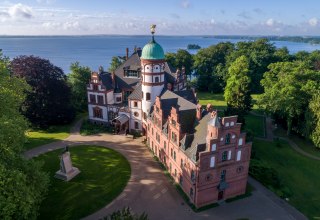The Grand Ducal Arsenal on the south-western bank of the Pfaffenteich in Schwerin, built between 1840 and 1844, is an impressive example of Tudor Gothic architecture. Today it serves as the seat of the state's Ministry of the Interior and combines historical architecture with a central location on the waterfront.
The impressive Grand Ducal Arsenal is picturesquely situated on the south-western bank of the Pfaffenteich in Schwerin. Designed by Georg Adolf Demmler and built between 1840 and 1844 by Hermann Willebrand and Gottlieb Ruge, the building originally served as an arsenal. Grand Duke Paul Friedrich's decision to move the residence to Schwerin contributed to the development of the area, which is considered the historical center of the city.
The style of the arsenal is based on Tudor Gothic, an English late Gothic style that was characteristic of the first decades of historicism. The massive towers and the crenellated eaves give the building a castle-like character, while the continuous ashlar jointing reinforces the impression of a stately palace on the waterfront. After the I. After the First World War, the Arsenal housed the police, and after the Second World War it served as accommodation for refugees. Since 1990, the Arsenal has been the seat of the Ministry of the Interior of Mecklenburg-Vorpommern.


















